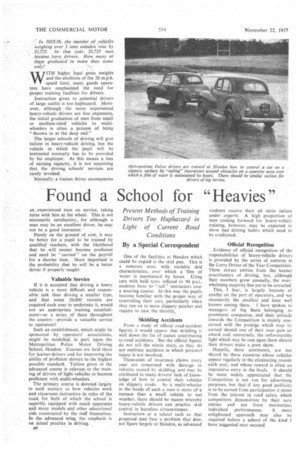Found a School for "Heavies"
Page 40

If you've noticed an error in this article please click here to report it so we can fix it.
Present Methods of Training Drivers Too Haphazard in Light of Current Road Conditions By a Special Correspondent
WITH higher legal gross weights . and the abolition of the 20 m.p.h.
speed limit, many goods operators have emphasized the need for proper training facilities for drivers.
Instruction given to potential drivers of large outfits is too haphazard. Moreover, although the more experienced heavy-vehicle drivers are fine exponents, the initial graduation of men from small or medium-sized vehicles to multiwheelers is often a process of being " thrown in at the deep end."
The larger schools of driving will give tuition in heavy-vehicle driving, but the vehicle in which the pupil will be instructed normally has to be provided by his employer. As this means a loss of earning capacity, it is not surprising that the driving schools' services are rarely invoked.
Normally, a trainee driver accompanies an, experienced man on service, taking turns with him at the wheel. This is not necessarily satisfactory, for although a man may be an excellent driver, he may not be a good instructor.
Purely on the ground of cost, it may be better for a pupil to be trained by qualified teachers, with the likelihood that he will sooner, become proficient and need be " carried " on the payroll for a shorter time. More important is the probability that he will be a better driver. if properly taught.
Valuable Service
If it is accepted that driving a heavy vehicle is a more difficult and responsible task than driving a smaller type, and that some 20,000 recruits are required each year to undertake it, would not an appropriate training establishment—or a series of them throughout the country—provide a valuable service to operators?
Such an establishment, which might be sponsored by operators' associations. might be modelled, in part, upon the Metropolitan Police Motor Driving School, Hendon. Courses arc held there for learner-drivers and for improving the ability of proficient drivers to the highest possible standard. Tuition given in the advanced course is relevant to the training of drivers of light vehicles to become proficient with multi-wheelers.
The primary course is devoted largely to such matters as how vehicles work and classroom instruction in rules of the road, for both of which the school is superbly equipped with much apparatus and many models and other educational aids constructed by the staff themselves. In the advanced wing, the emphasis is on actual practice in driving.
B6 One of the facilities at Hendon which could be copied is the skid pan. This is a concrete area, with variable skid characteristics, over which a film of water is maintained by hoses. Using cars with bald tyres inflated to 90 p.s.i.. students have to " tail " instructors over a weaving course. In this way the pupils become familiar with the proper way of controlling their cars, particularly when they run on to more slippery patches and require to ease the throttle,
Skidding Accidents
From a study of official road-accident figures, it would appear that skidding is well down the list of causes contributing to road accidents. But the official figures do not tell the whole story, as they do not embrace accidents in which personal injury is not involved,
Thousands of insurance claims every year are concerned with damage to vehicles caused by skidding, and may be attributed to many drivers' lack of knowledge of how to control their vehicles on slippery roads. As a multi-wheeler in the hands of such a man is more of a menace than a small vehicle in wet weather, there should be means whereby heavy-vehicle drivers can practise skid control in harmless circumstances.
Instructors at a school such as that proposed may face a problem that does not figure largely at Hendon, as advanced students receive their ab initio tuition under experts. A high proportion of men coming forward for heavy-vehicle training, however. may be expected to show bad driving habits which need to be eradicated.
Official Recognition
Evidence of official recognition of the responsibilities of heavy-vehicle drivers is provided by the series of contests in the Lorry Driver of the Year Competition. These attract entries from the keener practitioners of driving, but, although their numbers grow annually, the overwhelming majority has yet to be attracted.
This, I fear, is largely because of apathy on the part of operators, and not necessarily the smallest and least well known among them. I have spoken to managers of big fleets belonging to prominent companies. and their attitude towards the Competition is mainly concerned with the prestige which may he earned should one of their men gain an award and, conversely, the unfavourable light which may be cast upon them should their drivers make a poor show.
Happily, these sentiments, are not shared by those concerns whose vehicles appear regularly in the eliminating rounds each year, and whose reward is often an impressive entry in the finals. It should be more widely appreciated that the Competition is not run for advertising purposes, but that if any good publicity is to be earned from participation it stems from the interest in road safety which competitors demonstrate by their very entries and not from meritorious individual performances. A more enlightened approach may also he required before a school of the kind I have suggested may succeed.




























































































